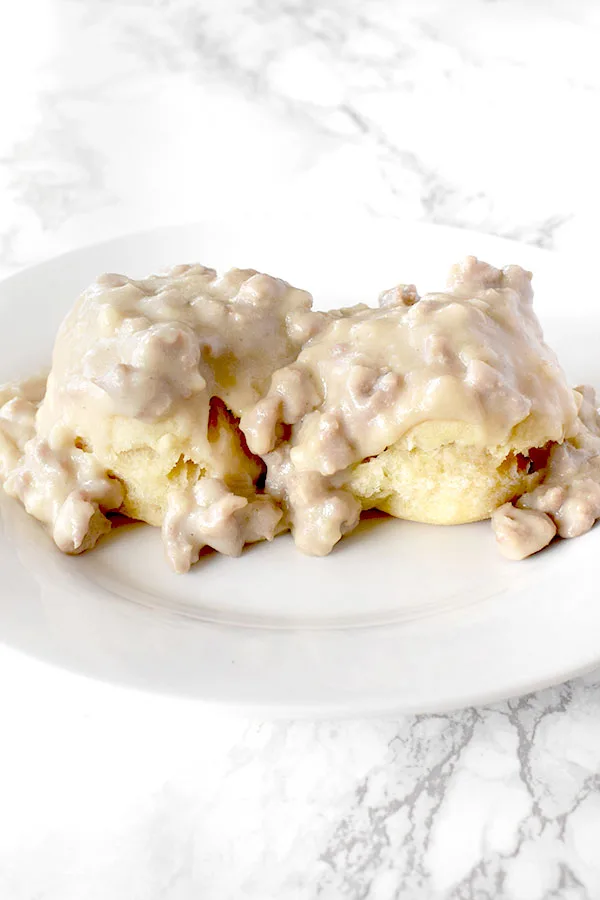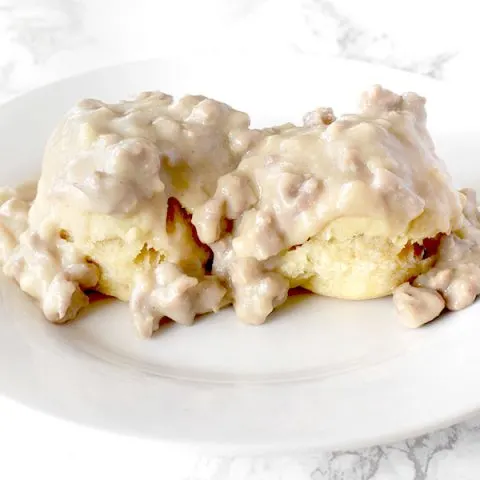These biscuits and gravy with oat milk are the classic Southern dish and you'll never know they are dairy free! Serve for breakfast for a traditional Southern experience.

There is something incredibly indulgent as well as delicious about biscuits and gravy. In fact, I had always wanted to taste it ever since I saw a picture of it.
My biscuits and gravy are made with oat milk, because they have to be dairy free. But, since my oat milk taste like real milk, I didn't feel like I was missing out on anything.
I also personally use ground beef because it is what I always have on hand, and both ground beef and sausages can be used for sausage gravy.
History of Biscuits and Gravy
Early European settlers in the United States brought with them a simple, easy style of cooking. It was usually based on ground wheat and warmed with gravy as a source of cheap nutrition. This was the foundation for biscuits.
The biscuit emerged as its own food in the early 1800s as a cheap addition to meals. It had the benefit of not requiring yeast.
At this point in time, bread was made only once a week. Also, yeast was a byproduct of making beer, commonly known as emptins.
So, if you lived in a city and close to a brewery, you had relatively easy access to it. However, if you were not so lucky, it was either difficult to attain or you had to try to make some version of it at home.
Even once panned yeast was created by the turn of the century, it was still not easy to acquire.
With due to the lack of yeast, beaten biscuits, or sea biscuits as they are known in New England, were developed. They were similar to hardtack.
These biscuits were beaten and folded to incorporate air into the dough, which expanded when heated in the oven, causing the biscuit to rise.
They were beaten for anywhere from 15 minutes to 45 minutes using a rolling pin, hammer, side of an ax, or handle of a musket.
These biscuits were eaten with gravy, and it wasn’t long before biscuits and gravy was created. The advantage of the biscuit over a slice of bread was that biscuits are firmer and therefore better for wiping up gravy.
Then, after the Civil War, biscuits and gravy became an actual dish because food was in short supply.
Also, a lack of money meant it had to be cheap and nutritious.
This was not unlike the early European settlers in the United States who ate ground wheat and warmed it with gravy because it was a source of cheap nutrition.
Breakfast was literally the most important meal of the day in the South for anyone facing a day of work on the plantations.
Then, with commercial baking powder becoming available in the middle of the century, it made the fluffy biscuit we know today possible. This, in turn, changed the face of biscuits and gravy to the delicious dish eaten all over the country.
WHAT IS A ROUX
A roux is equal parts flour and fat cooked together until it reaches a specific color.
It is used as a thickening agent for gravy, sauces, soups and stews, and have been used in French cooking for hundreds of years to thicken sauce.
The flour is added to the melted fat or oil on the stove top, blended until smooth, and cooked to the desired color.
A roux can be white and used for country gravy, blond for classic gravies, or brown, which is used in gumbo and jambalaya.
The lighter the roux, the more thickening power it has.
Once the roux is the desired color, liquids like stock are added.
WHY USE FLOUR TO THICKEN GRAVY
I use flour to thicken gravy because it gives the gravy that classic opaque, slightly pale look.
Many people don’t like using flour because if it isn’t cooked long enough, it can give a floury flavor to the gravy. Also, if not made properly, it can become clumpy.
The dood news is, making a smooth creamy gravy is a snap if you turn it into a roux first.
Another benefit some people see with gravy made with flour is that it keeps better in the fridge. This means it can be made ahead of time or be used for leftovers.
What can I use to substitute milk for biscuits and gravy?
Unsweetened mild flavored dairy free milks are a very good substitute for milk in biscuits and gravy. You can also use water, but the gravy won't be as opaque or white if you do. This recipe uses oat milk.
Choosing your Brand
I have tried a handful of oat milk brands and I can tell you, not all oat milks are created equal.
Some brands taste like oats and have the consistency of water. Other brands have a milder taste and are slightly reminiscent of milk. Oatly and Alpro are my two go-to brands.
When I visit New York, I really like Oatly, which I find to taste like regular milk and to be a little extra creamy. I'd assume this is true in Canada too.
In Israel, I only use the barista version of Oatly, which is still more watery than the regular Oatly in the States. I expect it is the same in Europe because that is where it is imported from.
For Israel and Europe, I find the Alpro oat milk indistinguishable from the Oatly Barista. However, the Alpro "Not Milk" oat milk I find to be almost identical to milk but a little sweeter - which I like.
IS KOSHER Meat BETTER?
Kosher animals are kept in better conditions than non-kosher animals due to strict kosher health requirements of the animals.
Also, the salting process used as part of the process of making meat kosher is similar to dry brining, and therefore produces a better quality meat.
While I’ve only eaten kosher meat and so I cannot compare, I’ve been told by non-Jews who do not keep kosher that they’ve noticed that kosher meat is of superior quality to cook with.
HOW TO DEFROST Meat
IN THE FRIDGE
Defrosting meat in the fridge is the most highly recommended.
To do this, place the frozen meat in a pan and let it thaw. Oftentimes when meat thaws, it releases liquids that can leak onto your fridge, so the pan is really helpful.
Meat typically takes a full day to thaw. Once thawed, it can remain in the refrigerator for a day or two before cooking.
IN COLD WATER
Defrosting meat in water should take two to three hours.
Submerge your sealed meat in a pot or bowl full of cold water. Change out the water every 30 minutes or so.
Do not use hot water because it can start cooking your meat.
Can you cook FROZEN meat?
According to the USDA, you can cook frozen meat. It will take 50% longer to cook, but it’s an option.
You should also cook it on a roasting rack or over vegetables so that the heat can circulate around the meat.
IS IT SAFE TO REFREEZE RAW meat?
According to the USDA, “food thawed in the refrigerator is safe to refreeze without cooking.” However, you do lose quality when refreezing previously defrosted meat.
Every time you defrost meat, it loses moisture as it thaws, which also leads to a loss in flavor. To compensate for this, marinate the meat to add more flavor and juice.
The USDA also says not to “refreeze any foods left outside the refrigerator longer than 2 hours; 1 hour in temperatures above 90°F.”
HOW TO STORE MEAT
Once cooled, place in an airtight container and refrigerate. Store for 3 to 4 days.
HOW TO FREEZE MEAT
Freeze leftovers within 3-4 days. Place in an airtight container or resealable freezer bag.
Freeze for up to 6 months. After that, it is still safe to eat but the quality begins to degrade.
Biscuits and Gravy with Oat Milk

This biscuits and gravy is made with oat milk and is the dairy free version of the classic Southern breakfast.
Ingredients
- 8 ounces sausage*
- ¼ cup flour
- 2 ½ cups mild flavored oat milk
- Salt
- Pepper
- Dairy Free Biscuits
Instructions
- Tear small pieces of sausage or ground beef and add them in a single layer to a large skillet or frying pan.
- Brown the sausage over medium-high heat stirring frequently.
- Reduce the heat to medium-low and add the flour. Stir it around and cook it for another minute to make a roux.
- Pour in the oat milk, stirring constantly. Cook the gravy, stirring frequently, until it thickens.
- Add salt and pepper to taste.
- Spoon the sausage gravy over warm biscuits and serve immediately.
Notes
*If you don't have sausage, ground beef is an acceptable substitute.
Nutrition Information:
Yield:
6Serving Size:
1Amount Per Serving: Calories: 191Total Fat: 11gSaturated Fat: 4gTrans Fat: 0gUnsaturated Fat: 6gCholesterol: 23mgSodium: 414mgCarbohydrates: 17gFiber: 1gSugar: 8gProtein: 6g